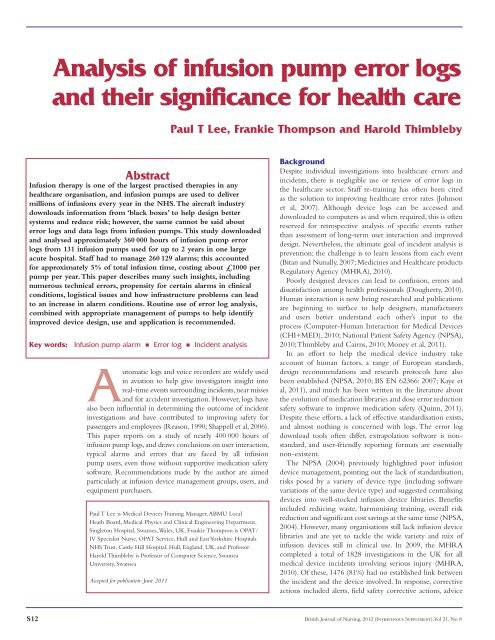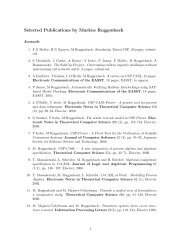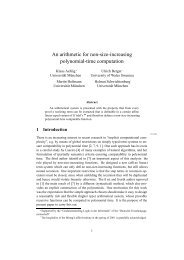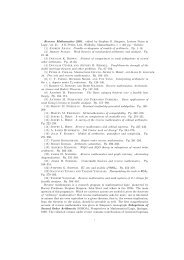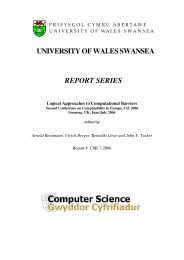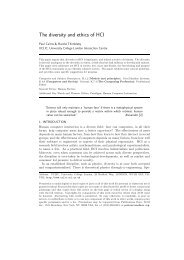Analysis of infusion pump error logs and their significance for health ...
Analysis of infusion pump error logs and their significance for health ...
Analysis of infusion pump error logs and their significance for health ...
You also want an ePaper? Increase the reach of your titles
YUMPU automatically turns print PDFs into web optimized ePapers that Google loves.
<strong>Analysis</strong> <strong>of</strong> <strong>infusion</strong> <strong>pump</strong> <strong>error</strong> <strong>logs</strong><strong>and</strong> <strong>their</strong> <strong>significance</strong> <strong>for</strong> <strong>health</strong> carePaul T Lee, Frankie Thompson <strong>and</strong> Harold ThimblebyAbstractInfusion therapy is one <strong>of</strong> the largest practised therapies in any<strong>health</strong>care organisation, <strong>and</strong> <strong>infusion</strong> <strong>pump</strong>s are used to delivermillions <strong>of</strong> <strong>infusion</strong>s every year in the NHS. The aircraft industrydownloads in<strong>for</strong>mation from ‘black boxes’ to help design bettersystems <strong>and</strong> reduce risk; however, the same cannot be said about<strong>error</strong> <strong>logs</strong> <strong>and</strong> data <strong>logs</strong> from <strong>infusion</strong> <strong>pump</strong>s. This study downloaded<strong>and</strong> analysed approximately 360 000 hours <strong>of</strong> <strong>infusion</strong> <strong>pump</strong> <strong>error</strong><strong>logs</strong> from 131 <strong>infusion</strong> <strong>pump</strong>s used <strong>for</strong> up to 2 years in one largeacute hospital. Staff had to manage 260 129 alarms; this accounted<strong>for</strong> approximately 5% <strong>of</strong> total <strong>infusion</strong> time, costing about £1000 per<strong>pump</strong> per year. This paper describes many such insights, includingnumerous technical <strong>error</strong>s, propensity <strong>for</strong> certain alarms in clinicalconditions, logistical issues <strong>and</strong> how infrastructure problems can leadto an increase in alarm conditions. Routine use <strong>of</strong> <strong>error</strong> log analysis,combined with appropriate management <strong>of</strong> <strong>pump</strong>s to help identifyimproved device design, use <strong>and</strong> application is recommended.Key words: Infusion <strong>pump</strong> alarm • Error log • Incident analysisAutomatic <strong>logs</strong> <strong>and</strong> voice recorders are widely usedin aviation to help give investigators insight intoreal-time events surrounding incidents, near misses<strong>and</strong> <strong>for</strong> accident investigation. However, <strong>logs</strong> havealso been influential in determining the outcome <strong>of</strong> incidentinvestigations <strong>and</strong> have contributed to improving safety <strong>for</strong>passengers <strong>and</strong> employees (Reason, 1990; Shappell et al, 2006).This paper reports on a study <strong>of</strong> nearly 400 000 hours <strong>of</strong><strong>infusion</strong> <strong>pump</strong> <strong>logs</strong>, <strong>and</strong> draws conclusions on user interaction,typical alarms <strong>and</strong> <strong>error</strong>s that are faced by all <strong>infusion</strong><strong>pump</strong> users, even those without supportive medication safetys<strong>of</strong>tware. Recommendations made by the author are aimedparticularly at <strong>infusion</strong> device management groups, users, <strong>and</strong>equipment purchasers.Paul T Lee is Medical Devices Training Manager, ABMU LocalHeath Board, Medical Physics <strong>and</strong> Clinical Engineering Department,Singleton Hospital, Swansea, Wales, UK, Frankie Thompson is OPAT/IV Specialist Nurse, OPAT Service, Hull <strong>and</strong> East Yorkshire HospitalsNHS Trust, Castle Hill Hospital, Hull, Engl<strong>and</strong>, UK, <strong>and</strong> Pr<strong>of</strong>essorHarold Thimbleby is Pr<strong>of</strong>essor <strong>of</strong> Computer Science, SwanseaUniversity, SwanseaAccepted <strong>for</strong> publication: June 2011BackgroundDespite individual investigations into <strong>health</strong>care <strong>error</strong>s <strong>and</strong>incidents, there is negligible use or review <strong>of</strong> <strong>error</strong> <strong>logs</strong> inthe <strong>health</strong>care sector. Staff re-training has <strong>of</strong>ten been citedas the solution to improving <strong>health</strong>care <strong>error</strong> rates (Johnsonet al, 2007). Although device <strong>logs</strong> can be accessed <strong>and</strong>downloaded to computers as <strong>and</strong> when required, this is <strong>of</strong>tenreserved <strong>for</strong> retrospective analysis <strong>of</strong> specific events ratherthan assessment <strong>of</strong> long-term user interaction <strong>and</strong> improveddesign. Nevertheless, the ultimate goal <strong>of</strong> incident analysis isprevention; the challenge is to learn lessons from each event(Bitan <strong>and</strong> Nunally, 2007; Medicines <strong>and</strong> Healthcare productsRegulatory Agency (MHRA), 2010).Poorly designed devices can lead to confusion, <strong>error</strong>s <strong>and</strong>dissatisfaction among <strong>health</strong> pr<strong>of</strong>essionals (Dougherty, 2010).Human interaction is now being researched <strong>and</strong> publicationsare beginning to surface to help designers, manufacturers<strong>and</strong> users better underst<strong>and</strong> each other’s input to theprocess (Computer-Human Interaction <strong>for</strong> Medical Devices(CHI+MED), 2010; National Patient Safety Agency (NPSA),2010; Thimbleby <strong>and</strong> Cairns, 2010; Money et al, 2011).In an ef<strong>for</strong>t to help the medical device industry takeaccount <strong>of</strong> human factors, a range <strong>of</strong> European st<strong>and</strong>ards,design recommendations <strong>and</strong> research protocols have alsobeen established (NPSA, 2010; BS EN 62366: 2007; Kaye etal, 2011), <strong>and</strong> much has been written in the literature aboutthe evolution <strong>of</strong> medication libraries <strong>and</strong> dose <strong>error</strong> reductionsafety s<strong>of</strong>tware to improve medication safety (Quinn, 2011).Despite these ef<strong>for</strong>ts, a lack <strong>of</strong> effective st<strong>and</strong>ardisation exists,<strong>and</strong> almost nothing is concerned with <strong>logs</strong>. The <strong>error</strong> logdownload tools <strong>of</strong>ten differ, extrapolation s<strong>of</strong>tware is nonst<strong>and</strong>ard,<strong>and</strong> user-friendly reporting <strong>for</strong>mats are essentiallynon-existent.The NPSA (2004) previously highlighted poor <strong>infusion</strong>device management, pointing out the lack <strong>of</strong> st<strong>and</strong>ardisation,risks posed by a variety <strong>of</strong> device type (including s<strong>of</strong>twarevariations <strong>of</strong> the same device type) <strong>and</strong> suggested centralisingdevices into well-stocked <strong>infusion</strong> device libraries. Benefitsincluded reducing waste, harmonising training, overall riskreduction <strong>and</strong> significant cost savings at the same time (NPSA,2004). However, many organisations still lack <strong>infusion</strong> devicelibraries <strong>and</strong> are yet to tackle the wide variety <strong>and</strong> mix <strong>of</strong><strong>infusion</strong> devices still in clinical use. In 2009, the MHRAcompleted a total <strong>of</strong> 1828 investigations in the UK <strong>for</strong> allmedical device incidents involving serious injury (MHRA,2010). Of these, 1476 (81%) had no established link betweenthe incident <strong>and</strong> the device involved. In response, correctiveactions included alerts, field safety corrective actions, adviceS12 British Journal <strong>of</strong> Nursing, 2012 (Intravenous Supplement), Vol 21, No 8
Total806040200Medical Surgical ITU Oncology MidwiferyFigure 1. Number <strong>of</strong> <strong>error</strong> log files by areaDivisionregarding safer device use, improved staff training <strong>and</strong> onmanufacturer undertakings to improve designs, processes <strong>and</strong>quality systems. Infusion devices continue to be one <strong>of</strong> <strong>their</strong>most active areas, with over 375 adverse incident reportsinvestigated during 2009.Although user <strong>error</strong> may sometimes be cited as the cause<strong>of</strong> an adverse incident, it may have simply contributed tothe cause; there are <strong>of</strong>ten other underlying reasons thatmay relate to device management, equipment maintenance,adequacy <strong>of</strong> training <strong>for</strong> users, sleep deprivation, or thedevice design <strong>and</strong> human interaction (Thimbleby <strong>and</strong> Cairns,2010). Infusion devices continue to be used extensively in<strong>health</strong>care, are considered as high-risk in organisational riskmanagement programmes <strong>and</strong> need to be safely managed(Lee, 2010). Monitoring <strong>error</strong>s <strong>and</strong> alarms, users reactions,<strong>and</strong> how <strong>infusion</strong> devices are used in a clinical setting, mighthelp designers, trainers <strong>and</strong> purchasers ensure safer, betterdesigned <strong>infusion</strong> devices <strong>for</strong> the future.StudyThe aim <strong>of</strong> the study was to download <strong>and</strong> analyse the <strong>error</strong><strong>logs</strong> from one type <strong>of</strong> volumetric <strong>infusion</strong> <strong>pump</strong> (Smiths/Graseby 500) used as st<strong>and</strong>ard in a large, 500-bed acutehospital. The <strong>logs</strong> record the frequency, type <strong>of</strong> alarms <strong>and</strong>common <strong>error</strong>s that occurred while in use in the clinicalsetting. The log data were compared <strong>for</strong> common alarmsacross each department <strong>and</strong> clinical disciplines.MethodError <strong>logs</strong> were downloaded during annual maintenancechecks <strong>and</strong> 165 <strong>logs</strong> from 131 different devices were selected<strong>for</strong> study. The <strong>pump</strong>s are only used by registered practitioners<strong>and</strong> have been used as st<strong>and</strong>ard across the organisation since<strong>their</strong> purchase in 2007.Only <strong>pump</strong>s configured <strong>for</strong> adult patients were selected<strong>and</strong> as no s<strong>of</strong>tware was available, a bespoke programme wasdeveloped to per<strong>for</strong>m data analysis <strong>and</strong> tabulate the results <strong>of</strong>the downloaded <strong>error</strong> <strong>logs</strong>.The <strong>infusion</strong> <strong>pump</strong>s store the most recent 200 eventsthroughout <strong>their</strong> period <strong>of</strong> use, dated <strong>and</strong> timed, plus acumulative total <strong>for</strong> each <strong>of</strong> 99 event codes. All devices hadthe same s<strong>of</strong>tware version (v3.66, 0.71) <strong>and</strong> motor s<strong>of</strong>tware(v1.10) installed, avoiding potential discrepancies that mightexist between different models <strong>of</strong> the same device type.Event <strong>logs</strong> between 2009 <strong>and</strong> 2011 were selected <strong>for</strong> thisstudy. A small number (n=7) were removed as they contained<strong>error</strong>s <strong>and</strong> significantly high numbers <strong>for</strong> each <strong>error</strong> code,suggesting a fault or s<strong>of</strong>tware corruption. Devices tested inquick succession were also removed. In total, 165 data filesout <strong>of</strong> 191 were accepted <strong>for</strong> the final analysis.The <strong>error</strong> log data files were converted into Micros<strong>of</strong>tExcel spreadsheets <strong>for</strong> ease <strong>of</strong> analysis. The manufacturer’sservice manual was used to identify each <strong>of</strong> the event codes<strong>and</strong> <strong>their</strong> indicative meaning, together with any correctiveactions. The <strong>error</strong> <strong>logs</strong> were stored on a file server at eachannual maintenance check, <strong>and</strong> then cleared from each<strong>pump</strong> to reset the counter. Any <strong>pump</strong>s that were sent <strong>for</strong>investigation, repair, or maintenance, during the annualperiod also had <strong>their</strong> data files downloaded, <strong>and</strong> these wereprocessed in the same way.Figure 1 shows the total number <strong>of</strong> files, <strong>and</strong> <strong>their</strong>respective care areas used <strong>for</strong> the final analysis. The data fileswere sorted by <strong>error</strong> code, clinical area, ward <strong>and</strong> frequency<strong>of</strong> alarms. Additional analysis helped compare <strong>and</strong> contrastaverage usage figures <strong>and</strong> frequency <strong>of</strong> alarms by divisions<strong>and</strong> department speciality.ResultsTotal time spent infusing medication/fluidsThe total time spent infusing medication or fluids (Table 1)exceeded 21 million minutes (362 778 hours), equivalentto a single device being used non-stop <strong>for</strong> 41 years.Administration sets were loaded 127 767 times <strong>and</strong> infused40 155 litres <strong>of</strong> intravenous medications/fluid across alldisciplines. Devices were used only 44% <strong>of</strong> <strong>their</strong> availabletime <strong>and</strong> indicated extensive use on battery power, <strong>of</strong>tenexceeding manufacturers’ maximum recommendation.Advanced featuresAdditional s<strong>of</strong>tware features are <strong>of</strong>ten supplied free <strong>of</strong> chargeby manufacturers; <strong>for</strong> example, the volume over time (VOT)calculator, which helps calculate <strong>infusion</strong> rates. Previousstudies have shown low confidence levels exist <strong>for</strong> maths <strong>and</strong>drug calculations in the nursing pr<strong>of</strong>ession (Hutton, 1998;Medical Devices Agency (now replaced by Medicines <strong>and</strong>Healthcare products Regulatory Agency), 2005; Lee, 2008),<strong>and</strong> despite the <strong>pump</strong> having this built-in feature it was onlyaccessed <strong>for</strong> 6% <strong>of</strong> all <strong>infusion</strong>s (n=7660). The lack <strong>of</strong> usemay simply be because users feel confident with <strong>their</strong> owncalculations, or they are unable to easily access the feature, orTable 1. Event codes <strong>and</strong> total timeCode Event Total85 Cumulative run time (minutes) 21 766 71782 AC on time (minutes) 19 956 74684 Charge time (minutes) 48 936 97383 Battery On time (minutes) 2 649 08288 Loading cycles 127 76787 Cumulative volume (litres) 40 155Volume over Time (VOT) calculations 7 660S14 British Journal <strong>of</strong> Nursing, 2012 (Intravenous Supplement), Vol 21, No 8
Safety clip (not fitted or faulty) 1757Motor reverse stall 1529Pressure plate (behind door) 2052Dead battery 2716Low battery 7421Door open 9386Air in line 20 180g enerated when the device has been left unattended <strong>for</strong>2 minutes; they are part <strong>of</strong> the normal operating <strong>and</strong> set upprocedure. No-flow alarm conditions can be generated byempty <strong>infusion</strong> bags, clamps left closed (above the <strong>pump</strong>) orinsufficient height <strong>of</strong> bag above the <strong>pump</strong>ing mechanism;they are difficult to interpret <strong>for</strong> this study, but <strong>their</strong>frequency can be noted.Figure 2. Top 10 alarm codesFrequencyOcclusion (below<strong>pump</strong>) 98 7624000003000002000001000000Figure 3. Occlusion settingsPause <strong>pump</strong>ing –excess pressuredetectedResume <strong>pump</strong>ing– pressurereducedPump alarmNo flow (above <strong>pump</strong>)55 308On hold (2 minutes lapsed) 58 955Stop <strong>pump</strong>ing –occlusionthey use st<strong>and</strong>ard <strong>infusion</strong> settings so this function may notbe required.In the authors' study, the use <strong>of</strong> this additional featurevaried considerably. Within oncology, the VOT calculatorwas used on average 69 times <strong>for</strong> each device, about 1.3% <strong>of</strong><strong>infusion</strong>s (total use = 5153); while in the anaesthetics divisionthe average use was 18 times per device: about 5.3% <strong>of</strong><strong>infusion</strong>s (total use = 336). These seem to be low rates <strong>of</strong> use,<strong>and</strong> suggest a range <strong>of</strong> further studies to explore issues such as:Does VOT provide a useful service <strong>for</strong> clinicians improvingsafety <strong>for</strong> patients? Is its low use a symptom <strong>of</strong> training or baddesign? These are important questions; the device <strong>logs</strong> studiedonly record how <strong>of</strong>ten these additional features are used, <strong>and</strong>are unable to provide insight into which <strong>infusion</strong>s are beingcalculated using this method.AlarmsFigure 2 summarises the top ten most frequent alarmconditions arising when the <strong>pump</strong> is stopped by the safetymechanism or by the user. Note that on-hold alarms areOcclusion alarmsInfusion devices attempt to maintain sufficient pressureon the medication or fluid to enable it to flow throughall restrictions (given the length/diameter <strong>of</strong> the tubing<strong>and</strong> any valves/filters), automatically increasing <strong>pump</strong>ingpressure to maintain the set flow rate. When the occlusionalarm is activated, the patient receives no or severely reduced<strong>infusion</strong> therapy. In the case <strong>of</strong> the <strong>infusion</strong> <strong>of</strong> medicationswith a short half-life this is critical, as it may result in plasmaconcentrations <strong>of</strong> a medication falling rapidly, with anassociated adverse physiological response.The correct occlusion alarm level setting is an essentialpart <strong>of</strong> the set-up procedure, <strong>and</strong> should be included duringtraining sessions <strong>and</strong> competency assessment strategies.Indeed, the MHRA include a large section in <strong>their</strong> InfusionDevices Bulletin (MHRA Device Bulletin, 2003) <strong>and</strong> go intogreat detail around this clinical setting <strong>and</strong> its importance.Occlusion alarms can help the clinical team determinewhether the default alarm setting needs to be altered, or thatan <strong>error</strong> has occurred, such as clamps left closed or <strong>infusion</strong>lines have become obstructed.Manufacturers use a variety <strong>of</strong> displays to help indicatethis important feature, ranging from graphical displays,numerical readings (in millimetres <strong>of</strong> mercury: mmHg) <strong>and</strong><strong>pump</strong>ing pressure indicators. However, the <strong>pump</strong> studiedhere has no visual display <strong>of</strong> pressure but has three builtinocclusion level options <strong>for</strong> the user to select from high,medium <strong>and</strong> low.In the <strong>logs</strong>, occlusion has far the highest prevalence <strong>of</strong>alarms <strong>for</strong> all conditions, being 37% <strong>of</strong> the top ten alarms<strong>for</strong> this device (n=98 762). Figure 3 shows the total number<strong>of</strong> pauses, restarts <strong>and</strong> subsequent occlusion alarms, whileFigure 4 shows the number <strong>of</strong> times the occlusion alarm levelwas changed. There were only 437 changes to these defaultsettings <strong>for</strong> this alarm (0.4%); this begs the question whetherthis setting should be automated, or perhaps is not really fullyunderstood by its users.The devices’ built-in pause function <strong>for</strong> occlusion showsthe highest number <strong>of</strong> events in the study (n=379 000),<strong>and</strong> note that the device does not actually alarm <strong>for</strong> thiscondition. The <strong>pump</strong> pauses during <strong>infusion</strong> if the pressuresensors detect a momentary occlusion or blockage in the<strong>infusion</strong> line. Should the blockage or occlusion clear itselfwithin 10 seconds (<strong>for</strong> example, as would occur if the patientrolled onto the <strong>infusion</strong> line then <strong>of</strong>f it again), the <strong>pump</strong> willresume with all preset limits intact. The resume function wasactivated in 74% <strong>of</strong> all <strong>infusion</strong>s <strong>and</strong> the full occlusion alarmoccurred in 26% <strong>of</strong> all pauses in therapy. Should <strong>infusion</strong>devices not have this ‘pause <strong>and</strong> restart’ function, then thenumber <strong>of</strong> alarms would be significantly increased in eachcare area <strong>and</strong> this should be noted.S16 British Journal <strong>of</strong> Nursing, 2012 (Intravenous Supplement), Vol 21, No 8
ERROR REDUCTIONAir in lineThere are clinical differences <strong>of</strong> opinion on the volume <strong>of</strong>air required to cause patient injury. Morling (1998) suggestedthat a large single bolus <strong>of</strong> air potentially presents a higherrisk than a similar volume <strong>of</strong> air made up <strong>of</strong> smaller bubbles.Certainly, in neonates a 0.5 mL air bubble can cause seriousinjury, <strong>and</strong> accidental <strong>infusion</strong>s <strong>of</strong> air into the bloodstream(air embolism) have been highlighted as a significant risk to<strong>health</strong> <strong>and</strong> listed in a number <strong>of</strong> investigations <strong>and</strong> fatalitiesby both the MDA <strong>and</strong> NPSA.In volumetric <strong>infusion</strong> devices, air can enter theadministration set from various sources, including incorrectpriming <strong>of</strong> the set, loose connections, inversion <strong>of</strong> the setduring use, <strong>infusion</strong> fluid degassing, or the administrationset running dry. The <strong>pump</strong> has a built-in safety functionthat automatically traps smaller air bubbles until a presetvolume has been collected, which can be removed using theautomated feature built into the door mechanism withoutthe need to disconnect the administration set connected tothe patient.Although the device studied here has a ‘no-flow above <strong>pump</strong>’alarm that should sound first, the <strong>logs</strong> show 55 308 incidences<strong>of</strong> this occurring.Figure 5 shows a high number <strong>of</strong> alarms (n=20 180) despitethe device’s ability to collect small air bubbles that wouldotherwise result in an alarm. The number <strong>of</strong> alarms per deviceis also shown (only one device studied had no alarms <strong>for</strong> thiscondition.) The highest number <strong>of</strong> alarms (n=7865) occurredin oncology. Each alarm should require intervention by theclinical team, <strong>and</strong> applying a nominal 5 minutes to deal witheach alarm. There are effectively over 45 weeks <strong>of</strong> nursingtime silencing <strong>and</strong> dealing with this alarm alone.Door-open alarmIn human <strong>error</strong> terms, the door-open alarm can be consideredas a workaround or violation <strong>of</strong> practice. There are nosituations where a door-open alarm makes operational sense,even if a patient is not currently being infused, <strong>and</strong> if apatient is being infused it represents an unacceptable risk <strong>of</strong>uncontrolled <strong>infusion</strong>.Although the safety clip (which reduces the risk <strong>of</strong> fluidfree-flow) should remain in place, the manufacturer is clearin its instruction manual that the clip should not be reliedon to stop the flow <strong>of</strong> medication (Smiths Medical Ltd.,2008). They go further <strong>and</strong> warn that the roller-clamp mustbe closed in all instances <strong>and</strong> that misuse may lead to death.Incidents have been recorded elsewhere when medicationshave been accidentally delivered at high flow rates owingto doors being inadvertently being opened during <strong>infusion</strong>therapy. Such safety features carry a high weighting factorin ensuring safer <strong>infusion</strong> devices are purchased in the NHS(MDA Device Bulletin, 2003; Lee, 2010).Despite a dedicated training programme, manufacturerinstructions, <strong>and</strong> posters across the organisation, the dooropenalarm condition occurred in all clinical areas. Figure 6shows the number <strong>of</strong> door open alarms per device (n=9386).Wards that admit patients into the hospital as well as theoncology service have a high number <strong>of</strong> alarms. One devicehad 335 door-open alarms when used <strong>for</strong> 2623 loading cyclesFrequency6004503001500Occlusion alarmsetting changeto lowFigure 4. Occlusion level changes by usersNumber <strong>of</strong> <strong>pump</strong>s (n=165)Figure 5. Air in line alarmsNumber <strong>of</strong> <strong>pump</strong>s (n=165)5040302010050403020100Figure 6. Door open alarmsOcclusion alarmsetting changeto mediumOcclusion settings(i.e. occurring in 1 out <strong>of</strong> 8 <strong>infusion</strong>s). Medical <strong>and</strong> surgicalward areas accounted <strong>for</strong> 20% <strong>and</strong> 18.5% respectively, <strong>and</strong>midwifery accounted <strong>for</strong> less than 1% <strong>of</strong> this alarm condition.It is clear, then, that log analysis highlights importantissues <strong>of</strong> clinical practice. While it is not clear when, <strong>and</strong>Occlusion alarmsetting changeto high0-50 51-100 101-150151-200 201-250251-300 351-400401-4500-1011-2021-3031-4041-50Number <strong>of</strong> alarms per <strong>pump</strong>Door open alarms per <strong>pump</strong>51-6061-7071-8081-9091-100101-110111-120121-200201-300301+British Journal <strong>of</strong> Nursing, 2012 (Intravenous Supplement), Vol 21, No 8S17
Frequency800060004000bed. St<strong>and</strong>ardising to electrical beds with air mattressesmeant that these two sockets are frequently in use. Otherdevices commonly used such as nebulisers, ECG monitors,non-invasive blood pressure machines, <strong>and</strong> personal phonechargers may also account <strong>for</strong> the increased dem<strong>and</strong> onbedside sockets <strong>and</strong> <strong>their</strong> impact may be an area <strong>for</strong> furtheranalysis. Such factors may account <strong>for</strong> the reliance, <strong>and</strong> overuse,<strong>of</strong> <strong>infusion</strong> <strong>pump</strong>s’ internal batteries, as the <strong>logs</strong> indicate.20000Figure 7. Battery alarmsStatus <strong>of</strong> <strong>pump</strong>- low batteryStop <strong>pump</strong>ing- dead batteryby whom, the alarm is activated, the fact that it occurs atall raises concern around clinical practice — <strong>and</strong> perhapsa misunderst<strong>and</strong>ing around how the door open featureshould be correctly activated. The organisation may need toinvestigate further ways in which to manage this risk.Battery use <strong>and</strong> alarmsThe importance <strong>of</strong> effective battery management has beenpreviously highlighted by the Department <strong>of</strong> Health <strong>and</strong>devices have been known to fail in use <strong>and</strong> to lead to seriousharm (MDA, 2005).Average battery use (known as the battery bucket),frequency <strong>of</strong> low battery alarms, <strong>and</strong> recharge time wereidentified via the <strong>error</strong> codes. For all devices, there wereover 55 000 separate occasions where <strong>pump</strong>s were usedsolely on battery. In total, 77.9% <strong>of</strong> all devices wereused on battery <strong>for</strong> up to 1 hour with 3.65% (n=2017)used <strong>for</strong> between 4 <strong>and</strong> 7 hours infusing. Evidently, themanufacturer’s maximum recommended battery usage <strong>of</strong> 6hours (longer on st<strong>and</strong>by) was frequently exceeded.The ratio <strong>of</strong> low battery to dead battery alarms was 3:1(Figure 7). Although each low battery alarm could not bedirectly linked from the <strong>logs</strong> to the corresponding deadbattery alarm <strong>for</strong> each device, the data clearly indicate ahigh number <strong>of</strong> safety critical events <strong>for</strong> these devices.Factors to consider in the day-to-day management <strong>of</strong>battery capacity include electrical infrastructure (i.e. amount<strong>of</strong> available sockets in each ward area), the provision <strong>of</strong>a battery management policy, an <strong>infusion</strong> devices libraryservice to help rotate stock <strong>and</strong> recharge batteries on aregular basis, <strong>and</strong> the lack <strong>of</strong> low battery indicator on eachdevice. It should be noted that the <strong>pump</strong> has an internalbattery test option but has no constant visual display duringoperation to show the user the battery charge level.Further analysis showed that 8 out <strong>of</strong> 10 <strong>of</strong> the highest<strong>error</strong>s in the battery use category appeared in the oncologydepartment. The highest single number <strong>of</strong> alarms <strong>for</strong> lowbattery condition (n=198) also resulted in 81 alarms <strong>for</strong>dead battery — just on a single <strong>infusion</strong> <strong>pump</strong>.Note that the hospital studied has an electricalinfrastructure built in the 1950s. Bedside mains socketsare limited <strong>and</strong> some bedsides have only two sockets perDiscussionThere is both a pr<strong>of</strong>essional <strong>and</strong> regulatory interest ininvestigating the cause <strong>of</strong> incidents involving medical<strong>infusion</strong> devices in <strong>health</strong> care (The Joint Commission,2009; MHRA, 2010). Ongoing analysis <strong>of</strong> user interactions,<strong>error</strong>s <strong>and</strong> common faults may point toward prematurecomponent failure, <strong>and</strong> design shortcomings, as well asgaps in training. As suggested by the authors’ findings, <strong>error</strong><strong>logs</strong> may help in this process. Better device management,measuring mean time between failures, tracking progress <strong>of</strong>repairs, or highlighting clinical practice issues can also beachieved using <strong>error</strong> log analysis.Equipment libraries that loan <strong>pump</strong>s to many clinicalareas will find it harder to analyse <strong>their</strong> <strong>logs</strong> <strong>and</strong> track whereissues <strong>of</strong> concern may be, as they will typically not be ableto pin down where each device is located <strong>for</strong> each loggedepisode. The authors suggest that new designs <strong>of</strong> <strong>pump</strong>should be able to log the start <strong>and</strong> end <strong>of</strong> loan periods, <strong>and</strong>in particular which medical speciality they are being used in.The findings, even though based on just one device typein use in one hospital, especially in relation to the lack <strong>of</strong>data integration <strong>and</strong> device <strong>logs</strong>, are likely to be relevant tomany other similar devices. The management <strong>and</strong> analysis<strong>of</strong> the logging process needs to be included in annualmaintenance protocols to ensure consistency, as this paperhas shown the substantial insights that can be obtained.Despite the emergence <strong>of</strong> dose <strong>error</strong> reduction s<strong>of</strong>tware(DERS), issues with device usability, with how staff accessfeatures, number <strong>of</strong> alarms <strong>and</strong> time management have beennoted throughout this paper. Ensuring timely download <strong>and</strong>analysis <strong>of</strong> log files is important, however, it has yet to beadopted as st<strong>and</strong>ard practice in the UK.In the authors’ <strong>logs</strong>, there were 260 129 alarms <strong>for</strong> allconditions, including technical <strong>error</strong>s, breakdowns, <strong>and</strong>call-back situations (e.g. no flow, occlusions, air-in-line).Assuming an average 5 minutes to deal with each alarm, atotal nursing staff time <strong>of</strong> over 13 staff years (at 37 hours/week, 44 week/year) can be attributed to dealing with thesealarm conditions <strong>for</strong> all intravenous <strong>infusion</strong>s — costingperhaps £260 000 in staffing hours alone.Such gross figures relate to the incidents in the <strong>logs</strong>analysed, <strong>and</strong> are relative to the number <strong>of</strong> <strong>pump</strong>s, the timeperiods covered by the <strong>logs</strong>, <strong>and</strong> the size <strong>of</strong> the hospital.However, the numbers can be generalised, making theinsights much more generic, but obviously less precise, <strong>for</strong>example:■■A nominal 5 minutes recovery time per alarm accumulatesto the equivalent <strong>of</strong> 6% <strong>of</strong> the total time spent infusing■■Approximately £1000 per <strong>pump</strong> per year is spent on staffingtime managing or recovering from alarm conditions.S18 British Journal <strong>of</strong> Nursing, 2012 (Intravenous Supplement), Vol 21, No 8
ERROR REDUCTIONLimitationsError <strong>logs</strong> are <strong>of</strong>ten large, difficult to interpret, <strong>and</strong> lackconvenient s<strong>of</strong>tware to present the data into an easy-tounderst<strong>and</strong><strong>for</strong>mat. Diagrams like those presented in this paperought to be generated automatically from <strong>logs</strong>. Although thealarms identified are easily categorised, the specific clinicalcircumstances leading to them are not. Error <strong>logs</strong> are rarelyreported in this graphical <strong>for</strong>mat, <strong>and</strong> this may be useful <strong>for</strong>annual reports <strong>and</strong> help organisations clearly identify, <strong>and</strong> targetthose <strong>error</strong>s <strong>of</strong> most <strong>significance</strong>. The devices in this studyrepresent less than a quarter <strong>of</strong> all devices in clinical use, but theactual cause <strong>of</strong> each alarm cannot be ascertained, as it was notdirectly observed. However, the implications remain the samethroughout; namely, any alarm that pauses or stops an <strong>infusion</strong>interrupts patient therapy <strong>and</strong> costs staff time. While a nominal5 minutes was used to estimate the time taken to deal witheach alarm in this paper, times vary in reality <strong>and</strong> depend onvarious factors, including the experience <strong>of</strong> the operator <strong>and</strong>the type <strong>of</strong> alarm (<strong>for</strong> example, the time taken to find anotherdevice in the event <strong>of</strong> a flat battery may take longer than thenominal 5 minutes). Alarms at initial set up can generally bedealt with in short periods <strong>of</strong> time, while alarms activated afterset up would require the nurse to leave the central area, identifythe device location, deal with <strong>and</strong> correct the alarm condition<strong>and</strong> re-instigate each <strong>infusion</strong>. Where there are infrastructureissues (as in this study, a lack <strong>of</strong> sufficient mains sockets) deviceswould also have to be swapped with fully-charged devices <strong>and</strong>the discharged devices moved to other locations <strong>for</strong> recharging.RecommendationsWhile it is impossible to ascertain what caused each <strong>of</strong> thealarm codes, the context in which they occurred, or how <strong>their</strong>frequency could be reduced, the fact that such large numbersoccur does raise concerns. In particular, without analysing <strong>logs</strong>,one cannot know how many alarms are being raised.The findings <strong>of</strong> this paper have shown the value <strong>of</strong>analysing <strong>infusion</strong> <strong>pump</strong> <strong>logs</strong>. <strong>Analysis</strong> can pinpoint areas <strong>for</strong>improvement <strong>and</strong> cost savings, as well as facilitate in<strong>for</strong>medtraining <strong>and</strong> other operational improvements. How usersreact to alarms, how many features are used in practice,<strong>and</strong> whether users access additional features have beenhighlighted by this study. This analysis can help target training<strong>and</strong> ensure timely staff education to meet changes in practice<strong>and</strong> dem<strong>and</strong>s <strong>of</strong> the service.This study has raised a number <strong>of</strong> key issues <strong>and</strong> to furthersupport the timely download, <strong>and</strong> ongoing analysis <strong>of</strong> <strong>error</strong><strong>logs</strong>, the authors suggest the following:■■Infusion <strong>pump</strong> <strong>logs</strong> should be easier to analyse withoutdeveloping bespoke s<strong>of</strong>tware (the authors had to build <strong>their</strong>own spreadsheet)■■Manufacturers should provide easy-to-use analysis s<strong>of</strong>tware,preferably con<strong>for</strong>ming to a st<strong>and</strong>ard (yet to be defined)so that <strong>logs</strong> from different device manufacturers can becombined <strong>for</strong> analysis■■Pumps should log more details <strong>of</strong> <strong>their</strong> use, such askeystroke events (this may help identify key bounce <strong>and</strong>other known problems)■■Pumps should be location aware, so that logged incidentscan be related more easily to clinical contexts■■The use <strong>and</strong> analysis <strong>of</strong> <strong>error</strong> <strong>logs</strong> should be promoted tohelp in<strong>for</strong>m <strong>and</strong> direct staff education <strong>and</strong> training■■Many alarm conditions could be avoided by better training<strong>and</strong> compliance <strong>and</strong> better infrastructure.ConclusionsBitan <strong>and</strong> Nunnally (2007) pointed out that <strong>infusion</strong> device<strong>logs</strong> are not the same as black boxes <strong>for</strong> the purposes <strong>of</strong>medication safety, nor can they be expected to be. Theaviation industry places great emphasis on the recovery<strong>of</strong> data <strong>logs</strong> (black boxes) to help review major incidents.Similarly, the data files <strong>and</strong> <strong>error</strong> <strong>logs</strong> in medical devices canbe used to bridge the gap that appears to exist between themanufacturers, users, <strong>and</strong> service personnel. If the purpose <strong>of</strong><strong>error</strong> analysis is to improve safety <strong>and</strong> organisational learning(Reason, 1990; Shappell et al, 2006; Johnson et al, 2007;MHRA, 2010) then device <strong>logs</strong>, <strong>their</strong> capture <strong>and</strong> ongoinganalysis, must be re-examined.Manufacturers should work more closely with <strong>health</strong>pr<strong>of</strong>essionals to help better interpret <strong>logs</strong> <strong>and</strong> to underst<strong>and</strong>the real-life situations that are recorded as occurring duringdevice use. Pressures <strong>of</strong> work, infrastructure issues, <strong>and</strong> unusedfeatures were found to exist in this study — raising questionsaround whether some features <strong>of</strong> <strong>infusion</strong> devices are fullyunderstood, or required, or should be better automated.Ongoing analysis <strong>of</strong> <strong>error</strong> <strong>logs</strong> <strong>and</strong> data files will helpthe underst<strong>and</strong>ing <strong>of</strong> how devices are used <strong>and</strong> should bedesigned. The study presented here shows that not all featuresprovided are being used, staff are adopting workarounds whileexposing patients to risk, ignoring persistent alarms, <strong>and</strong>collectively spending huge amounts <strong>of</strong> time recovering froma variety <strong>of</strong> alarm conditions. It is beyond the scope <strong>of</strong> thispaper to speculate which problems are caused more by pooruse <strong>and</strong> training (or learning) or by poor design itself causingthe poor work practices.For example, ‘not using all features’ may be caused bylack <strong>of</strong> awareness <strong>of</strong> users, work pressures, poor training,or merely that the features provided are difficult to accessor are inappropriate. The analysis shows that manufacturersare designing devices where features (e.g., VOT calculator)are not widely used, <strong>and</strong> overall are not being used safely<strong>and</strong> effectively — <strong>and</strong> on a scale that was not previouslyKEY POINTS• Infusion <strong>pump</strong> <strong>error</strong> <strong>logs</strong> are a valuable resource <strong>and</strong> can be used to helpidentify common alarms <strong>and</strong> themes <strong>for</strong> device users <strong>and</strong> managers• Many thous<strong>and</strong>s <strong>of</strong> alarms occur <strong>and</strong> go unreported <strong>and</strong> these can be avaluable resource to equipment trainers, managers <strong>and</strong> device designers• Infusion <strong>pump</strong> design issues <strong>and</strong> shortcomings can be highlighted by thesystematic analysis <strong>of</strong> <strong>error</strong> <strong>logs</strong>• The cost <strong>of</strong> dealing with alarms on <strong>infusion</strong> <strong>pump</strong>s should be considered byall purchasers• Manufacturers should be approached to supply full support <strong>for</strong> the ongoingdownload <strong>and</strong> ongoing analysis <strong>of</strong> <strong>infusion</strong> <strong>pump</strong> <strong>error</strong> <strong>logs</strong>British Journal <strong>of</strong> Nursing, 2012 (Intravenous Supplement), Vol 21, No 8S19
appreciated. Clearly, both hospitals <strong>and</strong> manufacturers canbenefit from thoughtful analysis <strong>of</strong> medical device data files<strong>and</strong> <strong>error</strong> <strong>logs</strong>. The hospital must react by improving training<strong>and</strong> awareness, <strong>and</strong>, equally, manufacturers must consider theimplications <strong>for</strong> new, safer, designs.In summary, <strong>infusion</strong> <strong>pump</strong> <strong>error</strong> <strong>logs</strong> have considerablescope to allow more insight into the actual, real-life events<strong>and</strong> environmental conditions that face <strong>health</strong> pr<strong>of</strong>essionalson a day-to-day basis, <strong>and</strong> this must be a good thing <strong>for</strong> thefuture. It should not be necessary to wait <strong>for</strong> isolated adverseincidents to occur <strong>and</strong> then analyse them; instead, widespread<strong>and</strong> routine <strong>error</strong> log analysis will strategically lead toimproved device interaction, reduced <strong>error</strong>s, <strong>and</strong> generallymaking things better <strong>for</strong> patients, equipment purchasers,users, designers, trainers <strong>and</strong> maintenance personnel. BJNAcknowledgementsThe log analysis s<strong>of</strong>tware was written <strong>and</strong> developed by Mr.Andrew Hutton (Clinical Technologist) Medical Physics <strong>and</strong> ClinicalEngineering Department, Singleton Hospital, <strong>and</strong> is thanked <strong>for</strong> hishelp <strong>and</strong> assistance during this study.FundingThis research was partly funded by Engineering <strong>and</strong> Physical SciencesResearch Council (EPSRC) on Computer-Human Interaction <strong>for</strong>Medical Devices, EP/G059063/1, see (CHI+MED, 2010).Thanks also to CHI+MED colleagues <strong>for</strong> valuable comments.Bitan Y, Nunally ME (2007) Can a log <strong>of</strong> <strong>infusion</strong> device events be used tounderst<strong>and</strong> <strong>infusion</strong> accidents? Journal <strong>of</strong> Patient Safety 3(4): 208–13. http://tinyurl.com/br222dy (accessed 17 April 2012)Computer-Human Interaction <strong>for</strong> Medical Devices (2010) www.chi-med.ac.ukDougherty L (2010) Design <strong>for</strong> patient safety. A guide to the design <strong>of</strong> electronic<strong>infusion</strong> devices. NHS, London. http://tinyurl.com/cczqtz7 (accessed 17 April 2012)Hutton M (1998) Nursing Mathematics: The Importance <strong>of</strong> Application. Nurs St<strong>and</strong>13(11): 35–8Johnson TR, Tanga X, Grahamb M, Brixeya J, Zhang J, Kesselmanb A, Vimla L,Patelb VL (2007) Attitudes toward medical device use <strong>error</strong>s <strong>and</strong> the prevention<strong>of</strong> adverse events. Jt Comm J Qual Patient Saf 33(11): 689–94Kaye RD, North RA, Peterson (2011) Conference Presentation: MK UPCARE: Ananalysis, description, <strong>and</strong> educational tool <strong>for</strong> medical device use problems. http://tinyurl.com/6q9ulo6 (accessed 17 April 2012)Lee P (2008) Risk score system <strong>for</strong> mathematic calculations in intravenous therapy.Nurs St<strong>and</strong> 22(33): 35–42Lee P (2010) A team approach to identify <strong>and</strong> manage risk in <strong>infusion</strong> therapy. BritishJournal <strong>of</strong> Nursing 19(5 Suppl): S12–18MDA (2005) Guidance on the safe <strong>and</strong> effective use <strong>of</strong> batteries <strong>and</strong> chargers<strong>for</strong> medical devices. ISBN 1-90-073152-5. DH, London. http://tinyurl.com/cem2r58 (accessed 17 April 2012)Medicines <strong>and</strong> Healthcare products Regulatory Agency Device Bulletin (2003) v2.0Device Bulletin: Infusion Systems. November 2010. ISBN 978 1 90 073172 XMedicines <strong>and</strong> Healthcare products Regulatory Agency (2003) DB2010 (03) April2010, Device Bulletin Adverse Incident Reports 2009. http://tinyurl.com/buzjclb(accessed 17 April 2012)Money AG, Barnett J, Kuljis J, Craven MP, Martin JL, Young T (2011) The role <strong>of</strong> theuser within the medical device design <strong>and</strong> development process: medical devicemanufacturers' perspectives. BMC Med In<strong>for</strong>m Decis Mak 11: 15Morling, S (1998), Infusion Devices: Risks <strong>and</strong> User Responsibilities. Br J Nurs 7(1):13–16, 18, 20National Patient Safety Agency (2004) Improving <strong>infusion</strong> device safety. Department. OfHealth, London. http://tinyurl.com/bvf878a (accessed 17 April 2012)National Patient Safety Agency (2010) Design <strong>for</strong> patient safety. A guide to the design <strong>of</strong>electronic <strong>infusion</strong> devices. NHS, London. http://tinyurl.com/cczqtz7 (accessed 17April 2012)Quinn C (2011) Smart practice: the introduction <strong>of</strong> a dose <strong>error</strong> reduction system.Br J Nurs 20(8 Suppl): 20–25Reason J (1990) Human Error. Cambridge University Press, New YorkShappell SA, Detwiler CA, Holcomb KA, Hackworth CA, Boquet AJ, WiegmannDA (2006). Human <strong>error</strong> <strong>and</strong> commercial aviation accidents: a comprehensivefine-grained analysis using HFACS. Federal Aviation Administration, Washington.http://tinyurl.com/793v5t6 (accessed 17 April 2012)Smiths Medical Ltd (2008) Graseby 500 volumetric <strong>infusion</strong> <strong>pump</strong> operator manual.Smiths Medical Ltd, KentThe Joint Commission (2009) Framework <strong>for</strong> Conducting a Root Cause <strong>Analysis</strong><strong>and</strong> Action Plan. The Joint Commission, WashingtonThimbleby H, Cairns P (2010) Reducing number entry <strong>error</strong>s: solving a widespread,serious problem. The Journal <strong>of</strong> the Royal Society <strong>of</strong> Interface Doi:10.1098/rsif2010.0112.S20 British Journal <strong>of</strong> Nursing, 2012 (Intravenous Supplement), Vol 21, No 8


